| Back to Back Issues Page |
 |
|
Bangkok Travelbug October13 Prasart Hin Phanom Wan - Korat September 26, 2013 |
| Hello
History of Prasart Hin Phanom Wan Prasart Hin Phanom Wan (prasart – abode of the gods, hin – stone) is one of the many Khmer sanctuaries in Korat and north-east Thailand that served as temples and sanctuaries for the pilgrims travelling from Angkor to north-east Thailand. It’s an old Khmer temple along the route from Khon Kaen to Phimai to the north and was built in the 10th C AD to worship Siva the Hindu god. Later blocks were added to the existing temple to expand it and temple became a Buddhist temple. 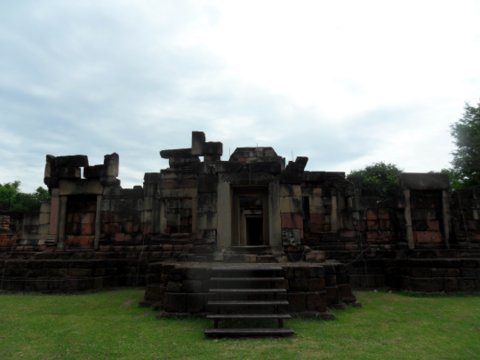
Prasart Hin Phanom Wan Prasart Hin Phanom Wan is similar in design to Prasart Hin Phimai 50 km to the north which is based on the design of Baphuon temple in Angkor, Cambodia. However, the temple at Phanom Wan is about a third the size of Phimai and the fifth largest in Thailand. Sometime in 1990 during archaeological digs under the main building, remains of human skeletons were discovered. These skeletons were in receptacles and had signs of burial ceremonies, not just remains discarded in the area. What’s more from tests, these skeletons were estimated to be at least 2,000 – 2,500 years old! This was long before Buddhism came to Thailand and that accounts for the burial instead of cremation ceremony. Back then the old community in Phanom Wan had waterways running south along what is now Highway 2 or Mittraphap Highway. The area was well irrigated and fertile. The area was considered auspicious and therefore improvements were constantly added to the temple instead of building a new one somewhere else. Over the years the temple was neglected, several areas had collapsed and many of carved lintels and Buddha statues were damaged or missing. 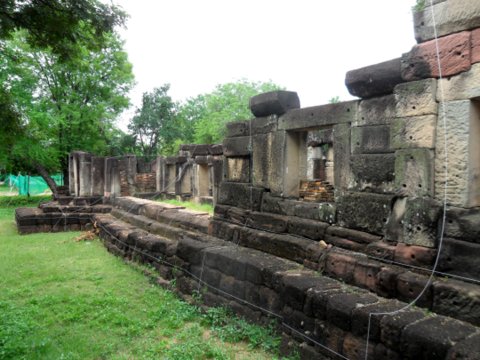
Collapsed section of the walls According to records there is a royal pavilion in the vicinity of Prasart Hin Phanom Wan, made from red sandstone and walled in with arched doors on all four sides. Beautifully carved lintels over the arched doorways surrounded by a moat. It’s a relatively newer design and in better condition than Prasart Hin Phanom Wan. King Jayaraman VI (1181 – 1220 AD)* resided at this royal pavilion during his pilgrimage in 13th C. He is considered to be one of the most dynamic kings in the Angkor Empire when the empire was at the height of its influence extending to Korat, Lopburi and Suphanburi. As there is no sandstone in the vicinity of Phanom Wan, these blocks, a mix of red and white sandstone, must be laboriously transported from somewhere else. This must have made the construction so much more difficult. In addition to assembling the blocks and carving the designs, they had to bring the blocks from afar. Unfortunately I only found out about this royal pavilion after my visit to the site and missed the chance to verify this. About 800 m away there is huge a lake about 500m by 300m, Sa Phleng that supplied water to the royal pavilion, the temple and community that lived there. Now I can understand the pride of the lady vendor who told me that this lake has been around since she was a little girl! 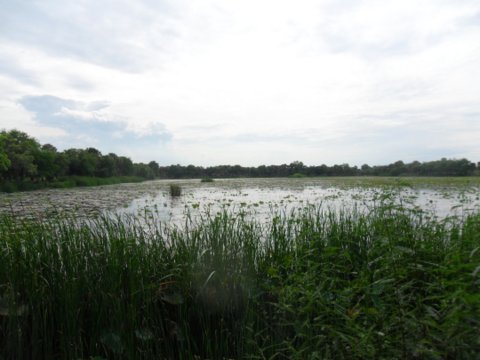
Sa Phleng During the two centuries after the death of King Jayaraman VI in 1220 AD, the Angkor Empire went into decline, fringe provinces like Lopburi broke away, constant wars and neglect caused the deterioration of the old temples like Prasart Hin Phanom Wan. Note *Historians are unclear as to the exact years that King Jayaraman VI was on the throne) Table of contents Tour of Prasart Hin Phanom Wan Restoration was in progress when we visited Prasart Hin Phanom Wan. Several areas were taped off and we were unsure as to whether we could enter. The vendors outside assured us that it’s still open to visitors. Admission was free. I don’t know whether it will remain so after restoration. 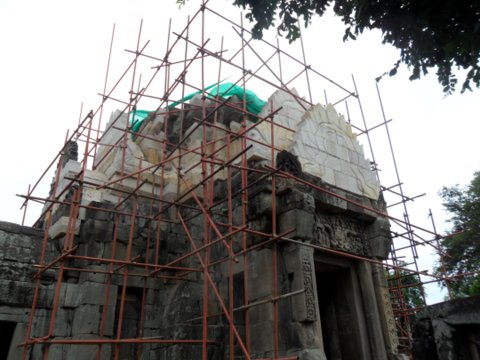
Restoring an old heritage Phanom Wan like the other Khmer temples I have visited is a square structure with concentric walls and doors on each side. 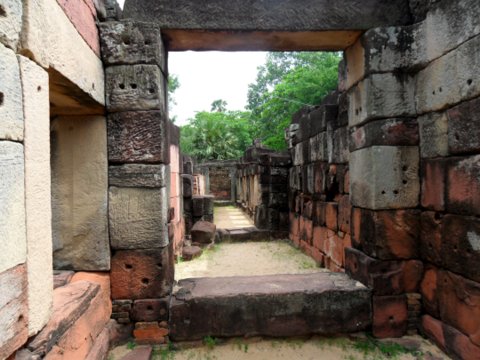
Double walls around the temple The temple is in ruins unlike the Phimai which is relatively intact. Parts of the walls are gone, the old sandstone blocks are heavily pitted and some of the blocks are chipped or missing. 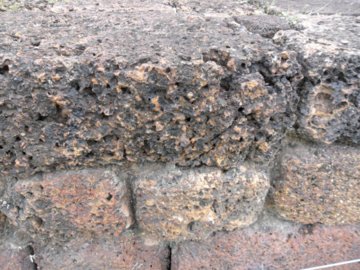
Condition of the blocks Several of the smaller buildings within the walls are in ruins. 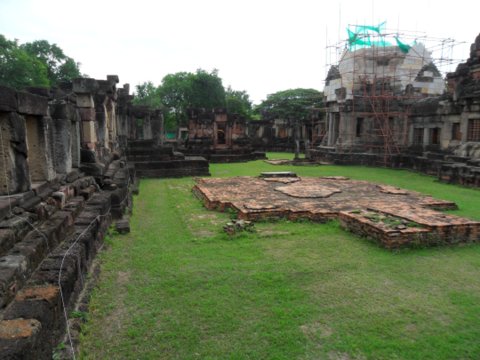
Within the walls Characteristically, the doors in the outer walls were aligned with the doors in the inner buildings. 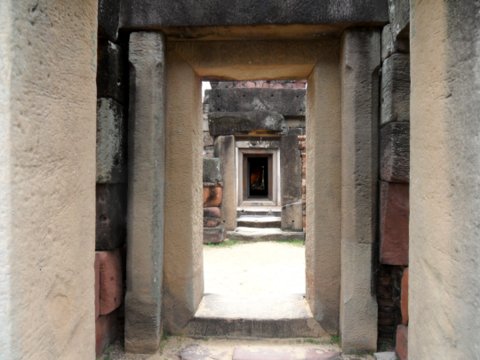
Leading right to the inner temple Unfortunately, many of the lintels, carvings and pillars are broken or missing. 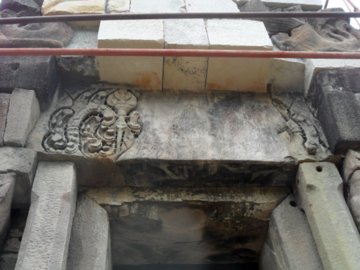
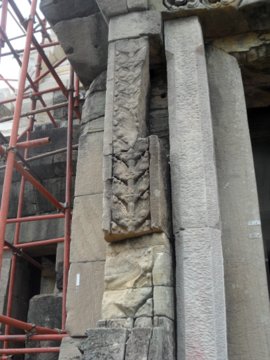
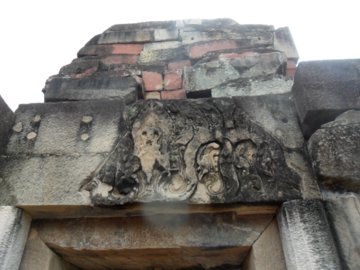
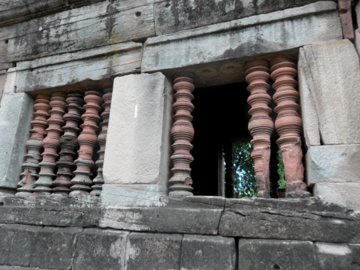
The altar in the inner building is still intact and there are signs of people having worshiped there. 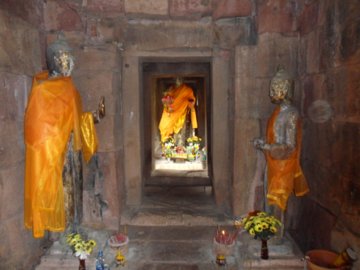
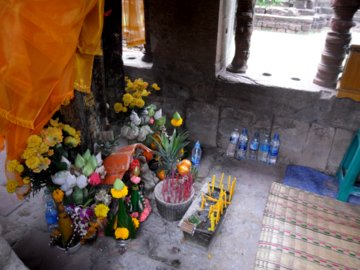
Outside the main temple, there is a pile of old stones with a crane which appeared to be raising a building with new blocks. I am not sure what this building is. 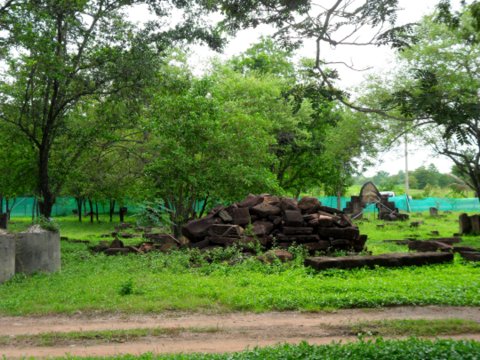
Stones outside the temple Table of contents A folk tale of two temples There is an old folk tale about the community in Phanom Wan. Long ago, the men and women here were constantly bickering as the women resented being treated slaves while the men lorded over them. The women got together to put a stop to this. After much discussion, they decided on throwing a challenge to the men in a contest of strength and skill. The men and women will build a temple each. Whoever finished the task first would be the winner. The winners would signal their completion by floating a lantern up in the air. These were the rewards and penalties for the winners and losers suggested by the women:
The women chose to build the temple in Phimai far away from prying eyes and the men’s mockery. They planned a big temple, built it up methodically, carving and decorating as the building was erected. The men chose to build a smaller temple at Phanon Wan as the rules didn’t specify the size. They thought a smaller temple will be completed faster. The women used a trick to complete their task quickly. For the pinnacle of the temple they used wood instead of stone and covered up the wooden structure with white cloth to disguise it as stone. Then they floated a lantern to announce completion. When the men saw the lantern, they were dispirited and stopped work, some were drinking in gloomy silence. Later the men went over to Phimai to concede defeat. They were furious when they discovered they were tricked. However good sense prevailed when they realized the point the women were trying to make; the women wanted respect, dignity and understanding. The men decided to help the women complete the temple at Phimai which became a monument of their love and understanding for one another. When they returned to Phanom Wan, they promised to stop the bickering and misunderstandings. To seal their pact, they ceased construction of the temple at Phanom Wan. That accounts for the relative size and condition of the two temples today. A folk tale no doubt but still it’s a gentle reminder for us not to take our loved ones for granted. 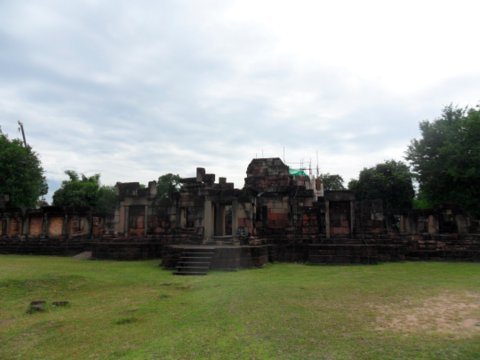
A gentle reminder Table of contents Map to Prasart Hin Phanom Wan View Prasart Hin Phanom Wan in a larger map How to get to there By car Take Highway 2 or the Mittraphap Highway to Korat city which is about 260 km from Bangkok. Enter the city and turn left to continue on Highway 2 on the road to Khon Kaen. It’s about a three hour drive to Korat city. You will reach a traffic junction about 20 km outside city at Tambon Ban Pho, turn right and go on for another 5 km to Prasart Hin Phanom Wan. By tour bus If you are using public transport, there are express tour buses from the Northern Bus Terminal at Mor Chit in Bangkok to the Korat bus terminal 2 (new terminal). This takes about three and a half hours and doesn’t cost more than 200 baht. If possible don’t take the air-conditioned non-express bus (class 2). It takes almost four and half hours (fare 171 baht). By mini-bus The mini-buses from the Victory Monument take three hours but terminate at Pak Chong (fare 180 baht). You will have to take another mini-bus to Korat city (fare 60 baht). Mini-buses from Mor Chit go directly to the bus terminal 2 in Korat city. Getting around Korat The most convenient form of public transport is the tuk tuk. These are available at the bus terminal and also at major junctions. If you are going to an out-of-the-way place like Phanom Wan, you’ll need to charter the tuk tuk for a return trip. Agree on the price before boarding. Table of contents Other attractions in Korat Tao Suranaree – the herorine of Korat The Jim Thompson Farm – Pak Thong Chai Prasart Hin Phimai - the Khmer sanctuary in Korat The beauty of Khao Yai National Park Table of contents My thanks I am grateful to Khun Tuk, the receptionist at Ploy Pavilion Hotel, Korat where I stayed who helpfully provided information on Prasart Hin Phanom Wan, Sa Phleng and the folk tale. This information was invaluable in writing this article. My thanks to my travelling companions Lim Siew Hwei who drove us, Wong Keng Cheong, Sally and family and cousin Mark who suggested the trip. Thank you for the company and the wonderful meals we had together. Thank you to Pastor Dickson Chiu of the mission station, Korat Logos Phisut Centre and Chua Kim Yien, manager of the Alpha Student Centre for your friendship and hospitality. Table of contents Next month The Fossil Wood Museum, Korat 

If you enjoyed reading this e-zine, please forward it to a friend. If you received this from a friend and found it interesting, please subscribe at Bangkok Travelbug. What you think of the Bangkok Travelbug? We love to hear from you What other subscribers have said Till next month then. Eric Lim Find us on Facebook Stay updated with what’s new at Tour Bangkok Legacies. Copy the link below and paste it into your Google Reader, NetNewsWire or your favourite feed reader. https://www.tour-bangkok-legacies.com/tour-Bangkok-legacies.xml If you use My Yahoo! or My MSN, head over to my home page and click on the button for your favourite Web-based feed reader. Visit our home page at Tour Bangkok Legacies. Copyright@2008-2013 Tour Bangkok Legacies All rights reserved |
| Back to Back Issues Page |